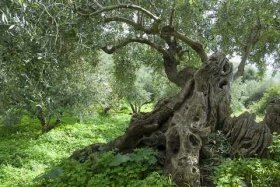Olive leaves
Olive leaves are processed into capsules, liquids, powders and teas.
Read on for benefits of each type and what to look for in a product.
Background :
Olive leaves are jam packed with plant antioxidants, the amazing broad spectrum antimicrobial oleuropein and its metabolites (broken down products) hydroxytyrosol and elenolic acid.

Hydroxytyrosol has a free-radical-scavenging (antioxidant) capacity about ten times that of Green Tea and readily crosses the blood-brain
barrier to protect nerve cells in the brain and spine.
Elenolic acid is antiviral in action and is the reason for the olive leaf's effectiveness against many viruses.
Some of the better known flavonoids are quercetin, which may have certain cancer-preventing properties according to recent research and oleocanthal which has anti-inflammatory and antioxidant properties.
Abundant research has gone into discovering what the different flavonoids in olive leaves can do, and thousands of years of use
demonstrate their safety and efficacy.
While science usually isolates and studies the individual constituents and their properties, it is the combination that produces a unique and
multi-faceted interaction with your body.
Of the 98 known constituents, oleuropein is used as a measure of the potency of a particular extract.
Brought back by Noah's dove, and signalling a new beginning after the flood recorded in the Bible, the olive leaf seems to hold out some
sort of hope for nearly everyone.
The exciting thing is to discover what it does for you.
1. Olive Leaf Capsules
Olive Leaf capsules contain dried olive leaves, concentrated powdered extracts of olive leaves or a combination of both with or without excipients (explained in the link below).
Effective for most uses they do not work as quickly as tinctures nor reach as high a concentration
in the blood which is good for stopping the beginnings of an infection in its tracks, but for
longer term systemic use and intestinal cleansing they are ideal.
2. Olive Leaf Liquid
Olive leaf extract liquid comes in ethanolic tinctures and water/glycerine-based liquid extracts.
The tinctures are fast acting and ideal for stopping early stages of viral and bacterial
infection in the upper respiratory tract and gut. They quickly reach much higher concentrations
in the blood than equivalent capsules and are more fully absorbed, so smaller doses can be taken
for an effective result.
They are also excellent for mouth/dental ulcers and infections and for topical use.
The water/glycerin extracts, while usually weaker than tinctures are good general
preventative tonics, absorb quickly like tinctures and contain no ethyl alcohol.
In high enough dosage are also very effective antimicrobials.
More about olive leaf extract tinctures
More about olive leaf water/glycerine extracts
3. Olive Leaves in Powder Form
Olive leaves may also be supplied in the form of powder or concentrated powdered extracts
which can be sprinkled on foods or taken in honey (for children especially) and in as many
other ways as your imagination will allow.
Their absorption characteristics would be similar to capsules.
More about olive leaf powder.
Of course a major use of the powder is in capsules, which you can make yourself. in the size and potency you desire.
4. Olive Leaf Tea
Olive leaf tea is a surprisingly pleasant-tasting beverage with a multitude of benefits.
It can easily be made from good quality dried olive leaves from your garden or is readily purchased on the internet.
Here are some benefits of olive leaf tea and some instructions on how to make it.

Sign up to our newsletter for special offers and tips about olive leaf extract.
Don't have much time to read? Our brief newsletters cover all you need to know and you won't miss out on our special offers either.
Some thoughts on olive trees
The resilience of olive trees is demonstrated by living examples believed to be between 3000 and 5000 years old - and they still produce
olives!
If the trunk and branches of an olive tree are damaged or die, often new shoots sprout from the roots and it continues to live.
The oldest olive tree is claimed to be in Vouves on the island of Crete (3000-5000 years old).
It has an intertwined network of a trunk which makes dating it a challenge.
There is also one in Palestine considered by experts to be about the same age. (They are not dated by rings in the trunk as most trees
are. The trunks of the old trees seem to be made of a network of smaller "trunks" fed by a common root system).

As bible history dates the Flood some 4400 years ago, there is the possibility that some currently existing olive trees pre-dated it.
At least one olive tree obviously produced shoots soon after the flood to provide a leaf for the dove to bring to Noah.
Could that same tree still be alive, 4400 years later in the area of Mt. Ararat?
An even more interesting thought is if an olive tree still bearing olives can be 5000 years old, is it not possible that it lived just
another 1000 years before that under the ideal pre-flood atmospheric conditions?
If that were the case, it could be an original olive tree created by God's Word on day 3 of Genesis!
It may even be smaller than the supposed "oldest ones" by having been partially destroyed and then springing up again.
That would make it a special tree.
If on a mobile device, to view or add comments click on "Full Site" tab.
Have You seen an ancient olive tree?
Olive leaves, trees, their fruit and uses are woven into the history of ancient and modern civilisations alike.
There is something very special about the olive tree.
If you have seen any that captured your imagination, why not tell us about it. If you have a photograph, please include that too.
What Other Visitors Have Said
Click below to see contributions from other visitors to this page...
Origins of the tea and the people who drank it
I stumbled on the tea quite by accident.
I own a gourmet food business, featuring olive oil, vinegar and teas and other food items.
Tea helped me …
Purple feet
I grew up in a rural part of Los Angeles that had been settled by Italians who found the climate perfect for olives. The whole area was planted in olive …
Oldest Olive Trees
I was born in Jerusalem but moved to the States when I was 5 years old. I went back to the West bank when I was 13 and lived in a small village.
My …




Comments
Have your say about what you just read! Leave me a comment in the box below. Note: I can't give medical advice. See dosage page for dosage.